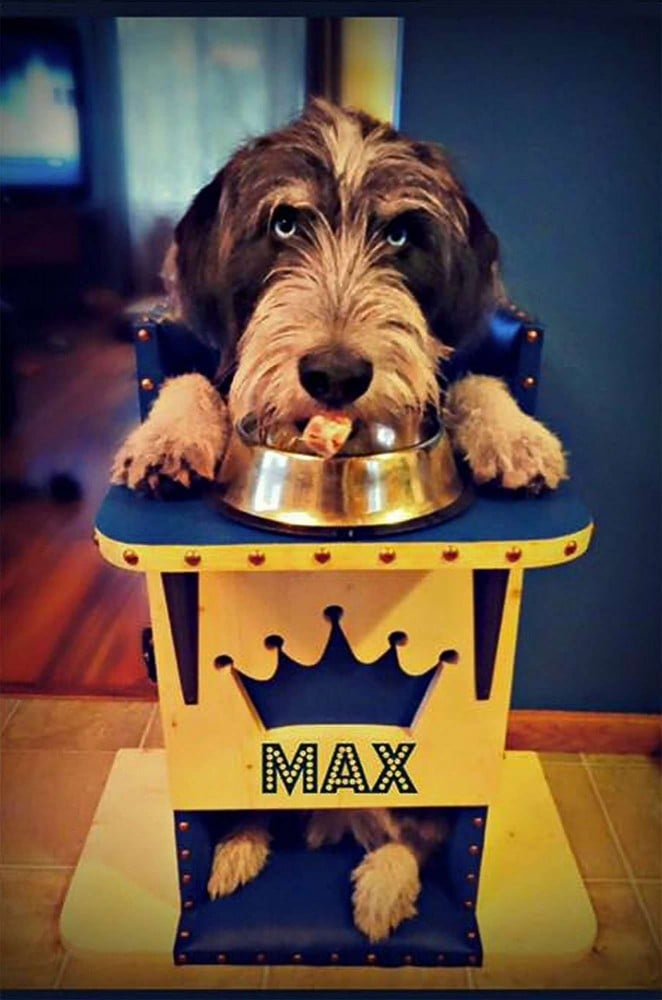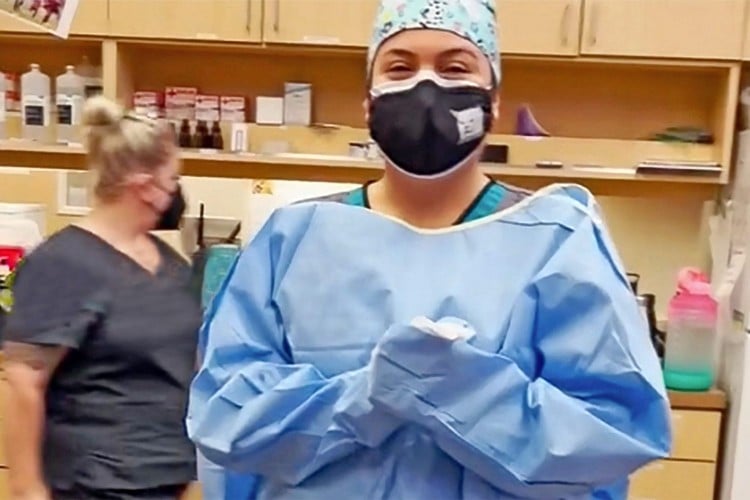What Is Megaesophagus in Dogs? And How Can You Best Care For Your Pup If They Have It?

Most dogs get excited at mealtimes and the mere mention of the word T-R-E-A-T. But what if your dog's food can't make it to his stomach? It sounds like a cruel trick of nature, but unfortunately some dogs have an esophageal condition called megaesophagus. When these dogs eat, the food just gets stuck in the esophagus or comes back up. The good news is that there are ways to help many dogs with this condition live happy, normal lives.
What Is Megaesophagus?
Megaesophagus causes the esophagus to become dilated, or enlarged. It loses tone and cannot effectively move food to the stomach. Dogs have difficulty swallowing and keeping food down, leading to malnourishment and weight loss. Food may become trapped in parts of the esophagus or get regurgitated back up. In some cases, food or liquid is aspirated, or inhaled, which can lead to pneumonia.
Causes of Megaesophagus in Dogs
Megaesophagus is caused by a condition that impairs the function of the esophagus. There are many potential causes of megaesophagus in dogs, many of which affect the muscles and nerves. Some cases are idiopathic, meaning the cause is unknown. Megaesophagus can be divided into two groups: congenital (present at birth) and acquired.
Congenital Megaesophagus
Some dogs are born with megaesophagus inherited from a parent. Most cases become apparent after puppies begin eating solid food. Inherited megaesophagus can occur in any mixed-breed or purebred dog, but it's more often seen in certain dog breeds:
Other cases of congenital megaesophagus are caused by birth defects, like a vascular ring anomaly. This is an extra band of esophageal tissue left over from fetal development that may compress the esophagus. The most common type of vascular ring anomaly is called a persistent right aortic arch, or PRAA. Other birth defects that cause megaesophagus in dogs include esophageal diverticula and congenital myasthenia gravis.
Acquired Megaesophagus
Acquired or adult-onset megaesophagus may be primary (idiopathic) or secondary to systemic disease. Signs begin in adulthood and the condition can affect dogs of any age or breed. Secondary diseases that may cause megaesophagus include:
- Myasthenia gravis
- Systemic lupus erythematosus
- Polymyositis
- Hypoadrenocorticism (Addison's disease)
- Hypothyroidism
- Toxin exposure—heavy metals such as lead or thallium, organophosphates (found in insecticides), botulism, tetanus
- Glycogen storage disease
- Dysautonomia
- Esophageal lesion such as an esophageal stricture, foreign body, cancer, or compression from another issue in the body
How Common Is Megaesophagus in Dogs?
Megaesophagus is somewhat common in dogs, mainly due to the fact that there are so many potential causes. The severity of megaesophagus varies greatly—some dogs are able to live relatively normal lives with assistance, while others require complex medical treatments. Sadly, some dogs succumb to the complications of megaesophagus or are euthanized due to poor quality of life.
Symptoms of Megaesophagus
The main sign of megaesophagus in dogs is regurgitation. Dogs tend to regurgitate undigested food shortly after eating. This is different from vomiting, where the dog heaves and throws up partially digested food and bile. When dogs vomit, the chest and stomach move as the dog visibly heaves. Regurgitation does not take this kind of effort.
Excessive drooling is also common in dogs with megaesophagus because they have trouble swallowing and keeping down saliva. And, because megaesophagus prevents food from reaching the stomach, dogs with this condition tend to lose weight and become malnourished.
Megaesophagus weakens the sphincter between the esophagus and stomach, making it easy for stomach acid to enter the esophagus (acid reflux). This can lead to ulceration of the esophagus. At the very least, these dogs are probably experiencing heartburn.
Dogs with megaesophagus have a greater risk of developing pneumonia because food and liquids can easily enter their airway. In fact, many dogs are not even diagnosed with megaesophagus until they develop pneumonia. These dogs usually experience coughing, difficulty breathing, and lethargy.
Diagnosing Megaesophagus
Contact your veterinarian if your dog is regurgitating food or liquid. Your vet will discuss your dog's history, perform a physical exam, and do chest X-rays look for air, fluid, or food in the esophagus. This typically involves a barium swallow—the dog is fed an edible contrast agent (it looks bright white on X-rays) and chest X-rays are taken at specific intervals. This allows the vet to see the shape and size of the esophagus and determine how long it takes for food to move down towards the stomach.
How to Make the Most of Your Vet Visit
Is There a Cure for Megaesophagus in Dogs?
While surgery can correct some birth defects, there is no cure for inherited or primary megaesophagus in dogs. Most of these dogs need life-long care to help them eat and keep down food.
If your dog has acquired megaesophagus, treatment is based upon the underlying cause (if known). Medications may effectively manage the primary disease and improve the function of the esophagus. However, many of these dogs still need special assistance.
How to Care for a Dog With Megaesophagus
Many dogs with megaesophagus can live relatively normal lives, but this requires careful home management and regular vet visits. The primary goals of long-term care are to provide nourishment and prevent aspiration.
Antacids are often used to control acid reflux. Various medications may be helpful to manage pain and protect the GI tract. Your vet may also recommend a supplement or herb, such as slippery elm, which lubricates and protects the lining of the GI tract.
Some dogs with severe megaesophagus need to have a stomach tube placed because they cannot keep food down at all. However, there are several techniques that help dogs with megaesophagus that don't require tube feeding. Your vet can help you develop a management plan for your dog's specific needs.
Upright Feeding
Feeding dogs in an upright or standing position uses gravity to move food to the stomach. One of the easiest ways to do this is with a special high chair. We love Bailey Chairs 4 Dogs—they make cute yet functional customized chairs for upright feeding. You can also use a laundry basket or make your own contraption.
The key is to feed your dog while he is standing on his two back legs (and resting his front paws on the chair). Dogs should remain in the vertical position for 10-15 minutes after each meal.
Know What to Feed and When
Many dogs with megaesophagus do best when fed small, frequent meals—often three to five times a day. Some dogs do best with "meatballs" of canned food because they are less likely to get stuck in the esophagus. Others respond better to food made into a slurry (a smoothie-like consistency). You may need to try a few different techniques to discover what works best for your pup. Your vet may also recommend a special diet or supplements to increase nutritional value.
Hydration
It can be difficult for dogs with megaesophagus to keep down water, so vets often recommend adding water to the food to maintain hydration. Some dogs will need supplemental fluid therapy, where fluids are injected under the skin (your vet can show you how to do this at home). One clever idea: Feed your dog small blocks of gelatin made with only water.
Special Gear
When walking dogs with megaesophagus, it's best to use a harness (rather than a neck collar and leash) so you don't put pressure on the esophagus. You may also want to consider a neck pillow or special collar that keeps your dog's head raised while he's lying down. When dogs with megaesophagus lie down, saliva and remaining food can easily come back up and may pool in the mouth. This increases the likelihood of aspiration pneumonia.
Seek Support
Your veterinarian is the best source of medical advice when it comes to managing your dog's megaesophagus. However, it's helpful to talk to other pet parents who have dealt with this before. The Upright Canine Brigade is an excellent resource for every pet parent caring for a dog with megaesophagus. You're not alone!








